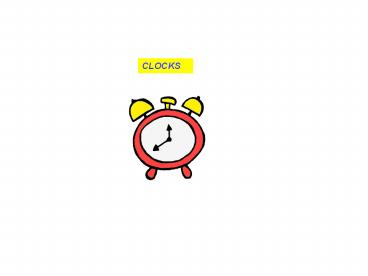CLOCKS - PowerPoint PPT Presentation
Title:
CLOCKS
Description:
Title: Slide 1 Author: Lois Laemle Last modified by: Lois Laemle Created Date: 10/19/2006 8:37:33 PM Document presentation format: On-screen Show Company – PowerPoint PPT presentation
Number of Views:99
Avg rating:3.0/5.0
Title: CLOCKS
1
CLOCKS
2
Clocks What is a clock? How does a biological
clock compare with a mechanical clock? Why have a
circadian clock? What are the properties of
circadian clocks? How do we set the circadian
clock?
3
CLOCKS
Measure Time
4
- All clocks must have two basic components
- a regular, constant or repetitive process or
action or OSCILLATION to mark off equal
increments of time - a means of keeping track of the increments of
time and displaying the result.
5
Oscillations are turned into time by matching
them to solar (light/dark) cycle
6
Earths rotation
0 90 180 270 360
6 a.m.
External Clock time (Time of Day)
Internal clock time
Text
7
- Mechanical Clock
- Oscillator a regular, constant or repetitive
process or action to mark off equal increments of
time. - Pendulum
- Balance wheels
- Vibrating crystal - quartz
- electromagnetic waves atomic clocks
- Output a means of keeping track of the
increments of time and displaying the result. - position of clock hands
- digital time displays.
8
MECHANICAL CLOCKS Pendulum clock 1656
Christiaan Huygens
1721 George Graham
1889
Siegmund Riefler Balance Wheels
1876 Quartz clocks
1920s 1969 Seiko 1972
Pulsar
1980 Swatch Atomic clocks
1955 cesium
9
- Mechanical Clock
- Oscillator a regular, constant or repetitive
process or action to mark off equal increments of
time. - Pendulum
- Balance wheels
- Vibrating crystal - quartz
- electromagnetic waves atomic clocks
- Output a means of keeping track of the
increments of time and displaying the result. - position of clock hands
- digital time displays.
- Resetting Mechanism
- manual
Biological Clock Oscillator pacemaker
neurons Output overt biological
rhythms Resetting Mechanism - zeitgeber Anticipa
tion
10
- Properties of Biological Clocks
- They continue to run under constant conditions.
- tau not exactly 24h
- They are Temperature Compensated
- They are affected by Light Intensity.
- They are under Genetic Control.
- They are Adjustable
- Zeitgeber
- Range of Entrainment
11
Why have a circadian clock? Coordinates body
activities with each other Synchronizes
individuals activity with the environment Anticip
ates predictable rhythmic changes in our
environment Gives animal best chance for survival
12
Where is the circadian clock?
scn
hypothalamus
13
(No Transcript)
14
Optic Nerve Optic Chiasm
15
Suprachiasmatic Nucleus (SCN)
Dorsomedial division Ventrolateral Division
Neuropeptides VIP (vasoactive intestinal
polypeptide GRP (Gastrin releasing peptide)
PHI (peptide histidine isoleucine)
16
Curtis Richter Lesion Stephan and
Zucker Ablation Arrhythmic
17
- Ablation eliminates circadian rhythms
18
- Criteria for identification of the clock
- Ablation eliminates circadian rhythms
- Electrolytic Lesion
- Chemical Lesion
- Circadian rhythm of activity exists within the
clock - Electrophysiological
- Metabolic -2Deoxyglucose
- Neurochemical synthesis
- Isolation of clock from rest of brain in vivo
eliminates overt rhythms but does not eliminate
rhythm within the clock. - Remove clock from the animal and clock still
exhibits a sustained circadian rhythm - Transplant clock cells back into lesioned,
arrhythmic animal restores rhythms
19
Stereotaxic instrument
20
Rhythmic Activity in situ Inouye and Kawamura
1970s Electrical Activity Schwartz et al 1980
Metabolic Activity
21
Remove clock from the animal and clock still
exhibits a sustained circadian rhythm
22
(No Transcript)
23
(No Transcript)
24
(No Transcript)
25
Rhythms within SCN Electrical activity high
during day, low at night Metabolic activity
active during day inactive at night Neurotransmit
ter synthesis
26
(No Transcript)
27
A structure exhibiting a regular
variation Injury Without a rhythm Total removal
Transported in the blood SCN lesioned Related to
time
Oscillator Lesion Arrhythmia Ablation Humoral SC
Nx temporal
28
Tau mutant A circadian period different
from 24h Wild type Non-mutant, control
organism Homozygous 2 identical alleles for a
trait Heterozygous 2 different alleles for a
trait In vitro in an artificial
environment outside the
living organism In vivo In the
living organism Electrode An
instrument which conducts an
electric current Explant
tissue removed from its normal place of
growth and placed into tissue
culture Organotypic Electrolyic made with
an electricl current Torpor dormant
or lethargic state
29
- Peripheral Oscillators
- Retina
- Fibroblasts
- Liver

